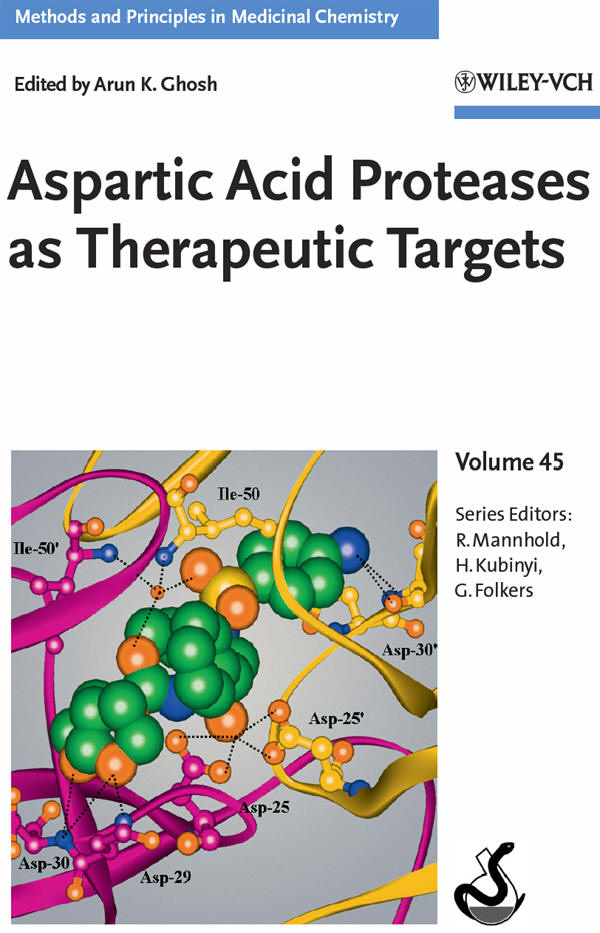The Ghosh Laboratories:
The Home of the Backbone Binding, Bioactive Natural Product Synthesis, and Nature-Inspired Molecular Design for Today's Medicine
Published Books
Parts two through five present various case studies of successful protease inhibitor drug design and development, as well as current and potential uses of such inhibitors in pharmaceutical medicine, covering the major therapeutic targets HIV-1 protease, renin, beta-secretase, gamma-secretase, plasmepsins, and fungal proteases.
A ready reference aimed primarily at professionals in the pharmaceutical industry, as well as for anyone studying proteases and their function.
Author Biographies
Arun K. Ghosh

Arun K. Ghosh received his BS and MS in Chemistry at the University of Calcutta and the Indian Institute of Technology, Kanpur, respectively. He obtained his Ph.D. (1985) at the University of Pittsburgh. He then pursued postdoctoral research at Harvard University (1985-1988). He was a research fellow at Merck Research Laboratories prior to joining the University of Illinois, Chicago as an assistant Professor in 1994. In 2005, he moved to Purdue University where he is currently the Ian P. Rothwell Distinguished Professor of Chemistry and Medicinal Chemistry. His notable honors include: ACS Medicinal Chemistry Hall of Fame, National Institutes of Health MERIT Award, CRSI medal from the Chemical Research Society of India, IUPAC Richter Award, Arthur C. Cope Scholar Award, Robert Scarborough Medicinal Chemistry Award, American Association for the Advancement of Science, University of Illinois University Scholar, National Merit Scholar of India. He has published over 260 research papers, edited a book on aspartic acid proteases and holds numerous patents. Professor Ghosh's research interests include diverse areas of organic, bioorganic, and medicinal chemistry with particular emphasis on organic synthesis and protein-structure-based design of biomolecules.
Part One: Overview of Aspartic Acid Proteases
- Chapter 1: Introduction to the Aspartic Proteinase Family (pages 1-21); Ben M. Dunn
- Chapter 2: Aspartic Proteases: Structure, Function, and Inhibition (pages 23-41); Jordan Tang
- Chapter 3: Human Aspartic Proteinases (pages 43-70); John Kay and Daniel Bur
- Chapter 4: Structure-Based Drug Design Strategies for Inhibition of Aspartic Proteinases (pages 71-105); Jon B. Cooper
Part Two: HIV-1 Protease as Target for the Treatment of HIV/AIDS
- Chapter 5: HIV-1 Protease: Role in Viral Replication, Protein-Ligand X-Ray Crystal Structures and Inhibitor Design (pages 107-137); Irene T. Weber and Yuan-Fang Wang
- Chapter 6: First-Generation HIV-1 Protease Inhibitors for the Treatment of HIV/AIDS (pages 139-168); Scott C. Virgil
- Chapter 7: Second-Generation Approved HIV Protease Inhibitors for the Treatment of HIV/AIDS (pages 169-204); Prof. Dr. Arun K. Ghosh and Bruno D. Chapsal
- Chapter 8: Darunavir, a New PI with Dual Mechanism: From a Novel Drug Design Concept to New Hope against Drug-Resistant HIV (pages 205-243); Prof. Dr. Arun K. Ghosh, Bruno D. Chapsal and Hiroaki Mitsuya
- Chapter 9: Development of HIV-1 Protease Inhibitors, Antiretroviral Resistance, and Current Challenges of HIV/AIDS Management (pages 245-262); Hiroaki Mitsuya and Prof. Dr. Arun K. Ghosh
Part Three: Renin as Target for the Treatment of Hypertension
- Chapter 10: Discovery and Development of Aliskiren, the First-in-Class Direct Renin Inhibitor for the Treatment of Hypertension (pages 263-296); Jeanette M. Wood and J-rgen Maibaum
- Chapter 11: Evolution of Diverse Classes of Renin Inhibitors through the Years (pages 297-324); Colin M. Tice and Suresh B. Singh
Part Four: γ-Secretase as Target for the Treatment of Alzheimer's Disease
- Chapter 12: γ-Secretase: An Unusual Enzyme with Many Possible Disease Targets, Including Alzheimer's Disease (pages 325-351);Johan Lundkvist and Urban Lendahl
- Chapter 13: γ-Secretase Inhibition: An Overview of Development of Inhibitors for the Treatment of Alzheimer's Disease (pages 353-390); Christopher L. Hamblett, Sanjiv Shah, Richard Heidebrecht and Benito Munoz
Part Five: β-Secretase as Target for the Treatment of Alzheimer's Disease
- Chapter 14: BACE: A (Almost) Perfect Target for Staving off Alzheimer's Disease (pages 391-412); Sukanto Sinha
- Chapter 15: The Discovery of β-Secretase and Development toward a Clinical Inhibitor for AD: An Exciting Academic Collaboration (pages 413-440); Jordan Tang, Lin Hong and Prof. Dr. Arun K. Ghosh
- Chapter 16: Peptidomimetic BACE1 Inhibitors for Treatment of Alzheimer's Disease: Design and Evolution (pages 441-479); Ulrich Iserloh and Jared N. Cumming
- Chapter 17: Nonpeptide BACE1 Inhibitors: Design and Synthesis (pages 481-509); Derek C. Cole and Matthew G. Bursavich
Part Six: Plasmepsins and Other Aspartic Proteases as Drug Targets
- Chapter 18: The Plasmepsin Family as Antimalarial Drug Targets (pages 511-547); Adam J. Ruben, Yoshiaki Kiso and Ernesto Freire
- Chapter 19: Plasmepsins Inhibitors as Potential Drugs against Malaria: Starving the Parasite (pages 549-571); Sandra Gemma
- Chapter 20: Fungal Aspartic Proteases as Possible Therapeutic Targets (pages 573-606); Michel Monod, Peter Staib, Utz Reichard and Olivier Jousson


